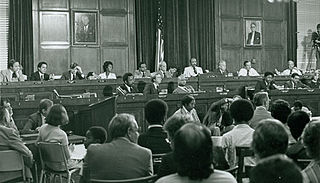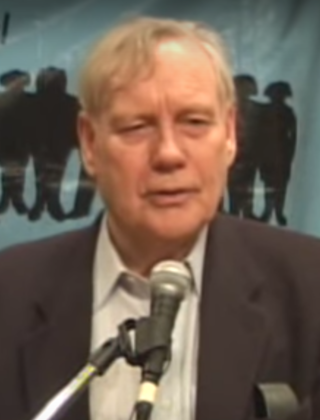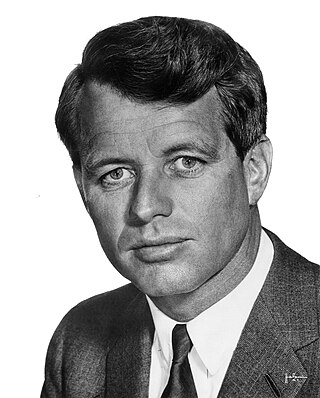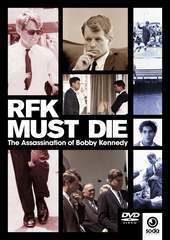
The President's Commission on the Assassination of President Kennedy, known unofficially as the Warren Commission, was established by President Lyndon B. Johnson through Executive Order 11130 on November 29, 1963, to investigate the assassination of United States President John F. Kennedy that had taken place on November 22, 1963.

The United States House of Representatives Select Committee on Assassinations (HSCA) was established in 1976 to investigate the assassinations of John F. Kennedy and Martin Luther King Jr. in 1963 and 1968, respectively. The HSCA completed its investigation in 1978 and issued its final report the following year, which concluded that Kennedy was probably assassinated as a result of a conspiracy. In addition to now-discredited acoustic analysis of a police channel dictabelt recording, the HSCA also commissioned numerous other scientific studies of assassination-related evidence that corroborate the Warren Commission's findings.
Arthur Herman Bremer is an American convicted criminal who attempted to assassinate U.S. Democratic presidential candidate George Wallace on May 15, 1972, in Laurel, Maryland, which left Wallace permanently paralyzed from the waist down. Bremer was found guilty and sentenced to 63 years in a Maryland prison for the shooting of Wallace and three bystanders. After 35 years of incarceration, Bremer was released from prison on November 9, 2007.

William Francis Pepper is a U.S. lawyer formerly based in New York City who is most noted for his efforts to prove government culpability and the innocence of James Earl Ray in the assassination of Martin Luther King, Jr. Pepper has also been trying to prove the innocence of Sirhan Sirhan in the assassination of Robert F. Kennedy. He is the author of several books, and he has been active in other government conspiracy cases, including the 9/11 Truth movement, and has advocated that George W. Bush be charged with war crimes.
Bernard Lee Diamond was a Professor of law and psychiatry at the University of California, Berkeley. He is primarily known for his contribution to what is known as forensic psychiatry. He was an expert witness for the defense in many well known trials, most notably the trial of Sirhan Sirhan, who was convicted of killing Robert F. Kennedy. The defense based much of their case on Diamond's testimony that Sirhan was suffering from diminished capacity at the time that he fired the deadly shots. In the 1980's, Jonathon Marks, who was representing Mark David Chapman for his alleged act of murdering John Lennon, brought Dr. Diamond in to perform medical legal evaluations on Chapman, but because Chapman later decided to plead guilty Diamond did not give testimony.
David Sánchez Morales was a Central Intelligence Agency operative who worked in Cuba and Chile.
The year 1968 saw a number of significant events in radio broadcasting history.

The Robert F. Kennedy presidential campaign began on March 16, 1968, when Robert Francis Kennedy, a United States Senator from New York, mounted an unlikely challenge to incumbent Democratic United States President Lyndon B. Johnson. Following an upset in the New Hampshire primary, Johnson announced on March 31 that he would not seek re-election. Kennedy still faced two rival candidates for the Democratic Party's presidential nomination: the leading challenger United States Senator Eugene McCarthy and Vice President Hubert Humphrey. Humphrey had entered the race after Johnson's withdrawal, but Kennedy and McCarthy remained the main challengers to the policies of the Johnson administration. During the spring of 1968, Kennedy led a leading campaign in presidential primary elections throughout the United States. Kennedy's campaign was especially active in Indiana, Nebraska, Oregon, South Dakota, California, and Washington, D.C. Kennedy's campaign ended on June 6, 1968 when he died following his assassination after declaring victory in the June 4, 1968 California Primary. He was assassinated at the Ambassador Hotel in Los Angeles, following his victory speech in the California primary and died on June 6, 1968 at Good Samaratin Hospital in Los Angeles. Had Kennedy been elected President in November of 1968, he would have been the first brother of a U.S. President to win the presidency himself.
Shane O'Sullivan is an Irish writer and filmmaker based in London. He is best known for his work on the assassination of Robert Kennedy. His feature documentary RFK Must Die is the first theatrical documentary on the case since Ted Charach's The Second Gun, which was released in October 1973. His book on the case, Who Killed Bobby? The Unsolved Murder of Robert F. Kennedy was published by Union Square Press to coincide with the fortieth anniversary of the assassination on 5 June 2008.

On June 5, 1968, Robert F. Kennedy was shot by Sirhan Sirhan at the Ambassador Hotel in Los Angeles, California and pronounced dead the following day.

Sirhan Bishara Sirhan is a Palestinian-Jordanian man who was convicted of murdering American politician Robert F. Kennedy, the younger brother of American president John F. Kennedy. On June 5, 1968, Sirhan shot and mortally wounded Robert shortly after 12 a.m. at the Ambassador Hotel in Los Angeles; Robert died the next day at Good Samaritan Hospital. The circumstances surrounding the attack, which took place five years after John's assassination, have led to numerous conspiracy theories.

Robert Francis Kennedy, also known by his initials RFK and by the nickname Bobby, was an American politician and lawyer. He served as the 64th United States attorney general from January 1961 to September 1964, and as a U.S. senator from New York from January 1965 until his assassination in June 1968, when he was running for the Democratic presidential nomination. Like his brothers John F. Kennedy and Ted Kennedy, he was a prominent member of the Democratic Party and is an icon of modern American liberalism.
The CIA Kennedy assassination is a prominent John F. Kennedy assassination conspiracy theory. According to ABC News, the Central Intelligence Agency (CIA) is represented in nearly every theory that involves American conspirators. The secretive nature of the CIA, and the conjecture surrounding high-profile political assassinations in the United States during the 1960s, has made the CIA a plausible suspect for some who believe in a conspiracy. Conspiracy theorists have ascribed various motives for CIA involvement in the assassination of President Kennedy, including Kennedy's firing of CIA director Allen Dulles, Kennedy's refusal to provide air support to the Bay of Pigs invasion, Kennedy's plan to cut the agency's budget by 20 percent, and the belief that the president was weak on communism.
Matthew Maxwell Taylor "Max" Kennedy is an American lawyer and author. He is the ninth child of Robert F. Kennedy and Ethel Skakel Kennedy.
There are several non-standard accounts of Robert F. Kennedy's assassination, which took place shortly after midnight on June 5, 1968, in Los Angeles, California. Kennedy was assassinated at the Ambassador Hotel, during celebrations following his successful campaign in California's primary elections as a leading 1968 Democratic presidential candidate; he died the following day at Good Samaritan Hospital.
Robert F. Kennedy visited the British Mandate of Palestine in 1948, one month before Israel declared its independence. Twenty-two years old at the time, he was reporting on the tense situation in the region for The Boston Post. During his stay, he grew to admire the Jewish inhabitants of the area. He later became a strong supporter of Israel; this was later cited as Sirhan Sirhan's alleged motivation for assassinating him on the first anniversary of the start of the Six-Day War on June 5, 1968. Sirhan happened to see a documentary about Kennedy in Palestine in 1948. Later in his murder trial, Sirhan Sirhan testified: "I hoped he will win Presidency until that moment. But when I saw, heard, he was supporting Israel, sir, not in 1968, but he was supporting, it from all the way from its inception in 1948, sir ..." Author Robert Blair Kaiser points out a discrepancy in the timing of Sirhan's decision. In Sirhan's diary, the entry in which he decided to kill Robert Kennedy was made on May 18. The documentary in question was first shown on TV in the Los Angeles area on May 20. When asked to explain, Sirhan said that he did not recall writing the journal.

Evan Phillip Freed is an attorney and freelance photographer who traveled with and photographed the presidential campaign of United States Senator Robert F. Kennedy. Freed was present when Sirhan Sirhan shot Kennedy.

The assassination of President John F. Kennedy on November 22, 1963, spawned numerous conspiracy theories. These theories allege the involvement of the CIA, the Mafia, Vice President Lyndon B. Johnson, Cuban Prime Minister Fidel Castro, the KGB, or some combination of these individuals and entities. Some conspiracy theories have alleged a coverup by parts of the federal government, such as the original FBI investigators, the Warren Commission, or the CIA. Former Los Angeles District Attorney Vincent Bugliosi estimated that a total of 42 groups, 82 assassins, and 214 people had been accused at one time or another in various conspiracy scenarios.
The Directorio Revolucionario Estudiantil was a Cuban student activist group launched in opposition to Fidel Castro in 1960, based at the United States, where it soon developed links with the Central Intelligence Agency. In August 1962 it carried out an attack on a beachfront Havana hotel. As of 1963, it was the largest anti-Castro student group in Miami; it also had a chapter in New Orleans, where it had contact with Lee Harvey Oswald in mid-1963. Immediately after the November 22, 1963 assassination of John F. Kennedy, it launched a campaign asserting that Lee Harvey Oswald had been acting on behalf of the Cuban government. The group lost its CIA support in December 1966.

Paul Schrade was an American trade union activist. While vice president of the United Auto Workers, he was shot in the head during the 1968 assassination of Robert F. Kennedy. Schrade believed that while he was shot by Sirhan Sirhan, Kennedy was shot by a second gunman. Paul Schrade is featured in the Netflix documentary Bobby Kennedy for President. The Paul Schrade Library at the Los Angeles High School of the Arts was named after him.











